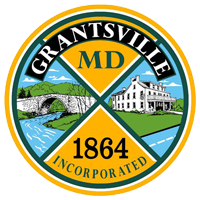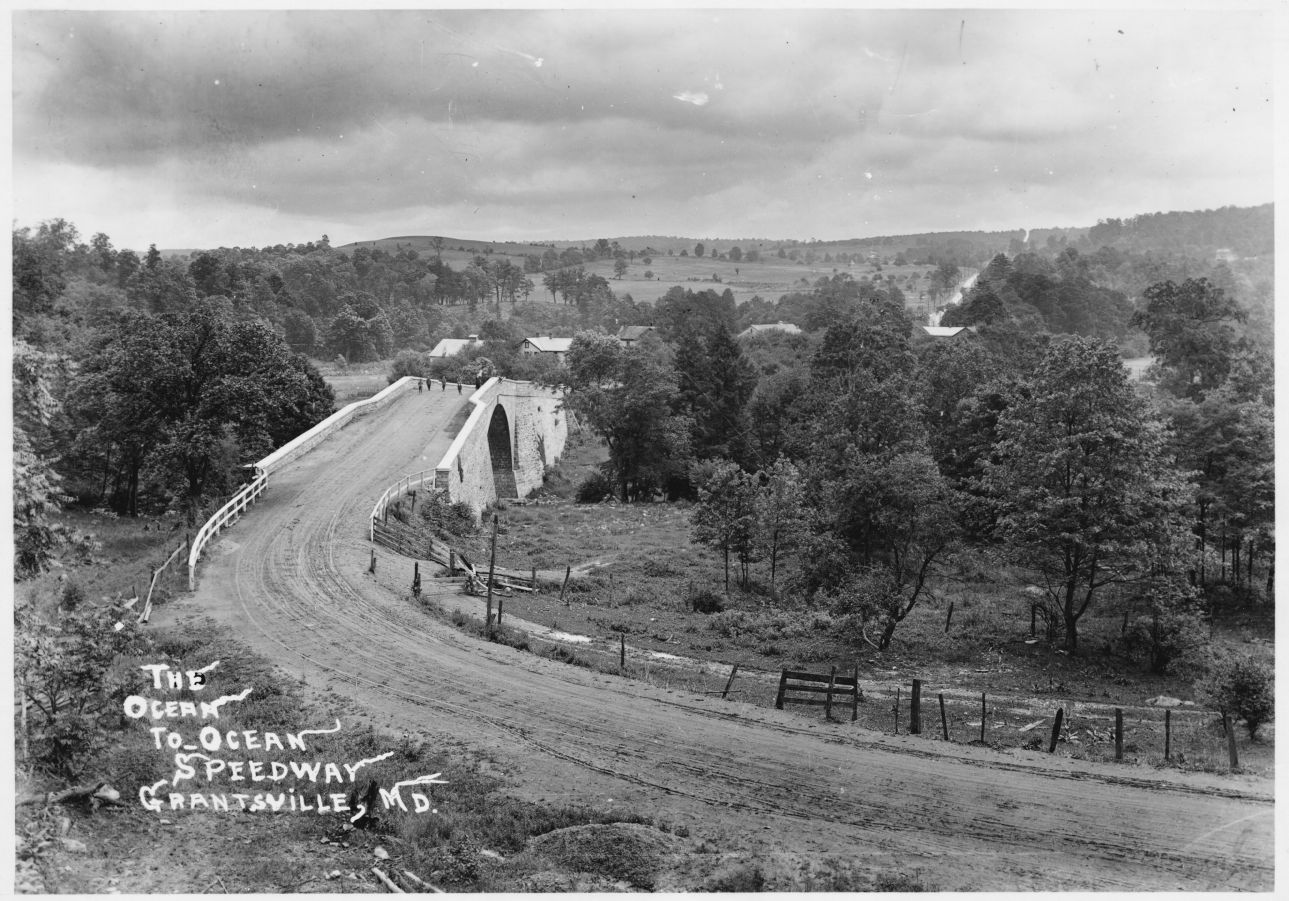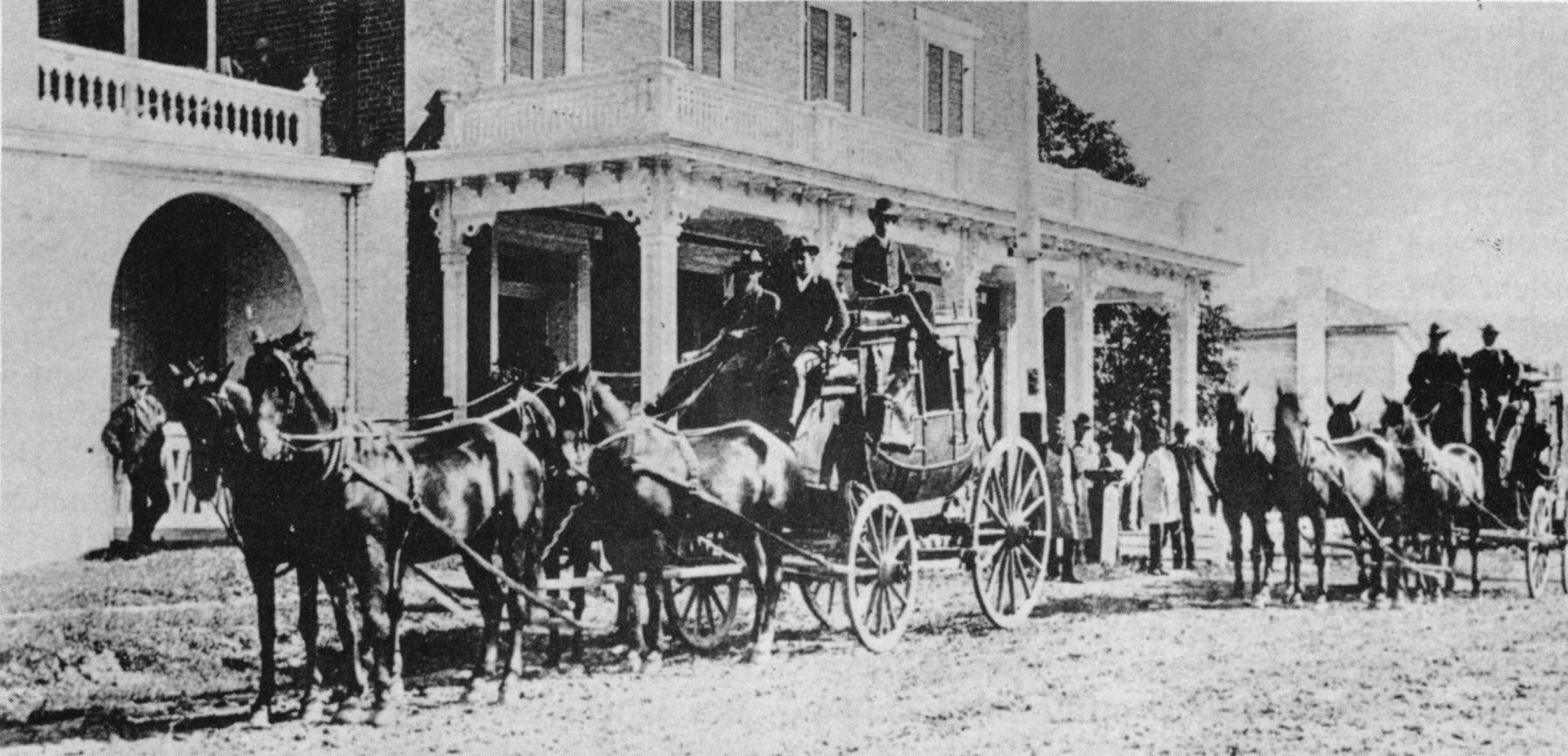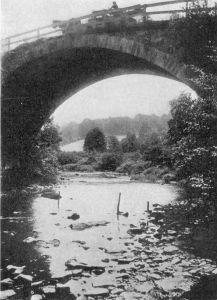Grantsville History
Grantsville’s Beginnings
In 1785 Daniel Grant of Baltimore acquired an 1100 acre tract of land called “Cornucopia.” The town of Grantsville is located in the center of this tract, named in honor of Daniel Grant. When he moved to the area in 1796 he was the wealthiest person in the county. We were part of Allegany County at that time. Garrett was established as a separate county in 1872, named after John Garrett, president of the B&O Railroad.
Little Crossings was the town center of those days. It was located where we find Stanton’s Mill and the old Casselman Bridge today. Prior to Mr. Grant’s arrival on the scene, this area was mostly wilderness but saw traffic from such famous men as George Washington and General Braddock. They passed through here in 1755 on their way to Pittsburgh as part of the ill-fated campaign against Fort Duquesne and the French. They had camps near Hilltop and Little Crossings. These travels prompted the construction of the Braddock Road which roughly followed the Indian trail Nemacolin’s Path.
Between 1811 and 1818, the National Road was constructed along the general route of Braddock’s Road. Currently Alt. Route 40, the National Road was the first federally funded highway in the U.S and brought much traffic through our area as settlers moved west. Most heavily traveled in the 1840’s, an abundance of accommodations existed for the traveler, some of which can still be seen today. As part of the National Road project, the Casselman Bridge was built in 1813. A handsome stone arch, it was the largest single span bridge of its day and was used until the early 1950’s. You can now enjoy its beauty from the state park at its feet.
Grantsville contains many historical sites.
Photography adapted by General Graphics, Cumberland, MD
Photography credit: Federal Highway Administration
Extended History: Early Roads
Convoys of packhorses were the principal means of conveying freight by land throughout the 1700’s. Nemacolin’s Path was constructed as a packhorse trail in 1753. The Ohio Company authorized Thomas Cresap to mark and improve this trail, which Christopher Gist had explored two years earlier. The trail was named for Delaware Indian Nemacolin who provided assistance to Cresap. The path connected Wills Creek (Cumberland, MD) to Redstone Old Fort (Brownsville, PA). This road gave access from the Potomac River to the Monongahela River. From Fort Redstone one could continue on foot or by water to the Forks of the Ohio (Pittsburgh, PA). Nemacolin’s Path likely passed on the north side of modern Grantsville, MD.
Braddock’s Road was built by the troops of British General Edward Braddock in 1755 at the outbreak of the French and Indian War. The troops were marching through here on their way toward Fort Duquesne (Pittsburgh, PA). They were part of the ill-fated British campaign against the French. The troops needed a wagon road in order to haul artillery and heavy supplies. Their road building would be considered primitive by today’s standards, as it consisted primarily of tree and rock removal.
George Washington participated in this campaign. He traveled through our area on five trips between 1753 and 1784. Braddock’s Road followed the route of Nemacolin’s Path from Fort Cumberland into Pennsylvania. The road then went north past the Youghiogheny River to the battle site with the French, on the Monongahela River (Braddock, PA). Braddock’s Road passed on the south side of modern Grantsville, MD.
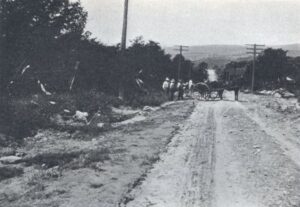
National Road near Grantsville. Photography credit: Federal Highway Administration
The National Road (also known as the Cumberland Road) was constructed between 1811 and 1818 along the general route of Braddock’s Road. Extending from Cumberland, MD to Wheeling, WV, it was the first federally funded highway in the U.S. Under the administration of President Thomas Jefferson, Congress approved funding for the road in 1806. As one of the most important east-west routes in the nation, it brought lots of mail, freight and travelers through our area. By 1818, stagecoaches ran regularly scheduled routes. Traffic on the National Road peaked in the years between 1822 and 1852. An abundance of accommodations existed for the traveler, some of which can still be seen today. As part of the National Road project, construction of the Casselman Bridge began in 1813. A handsome stone arch, it was the largest single span bridge in the country and was open to traffic until 1953.
Between 1825 and 1852 the National Road was extended from Wheeling to Vandalia, Illinois. After the Baltimore & Ohio Railroad reached Cumberland in 1842, passengers transferred from trains there onto stagecoaches to travel west to the Ohio River. When the B&O Railroad reached Wheeling in 1853, rail travel began to replace horse-drawn road travel, and traffic on the National Road declined. Today the National Road is designated as Alt. Route 40.
Early Settlements
During the 1700’s there were some permanent Native American villages along the river valleys in this area. There were also seasonal residences. Native Americans moved here to establish hunting camps during the summer months, returning to their permanent homes for the winter.
Long before the town of Grantsville was established, a settlement called Little Crossings emerged where we now find Penn Alps and the old Casselman Bridge. Little Crossings is where George Washington and General Braddock forded the Little Youghiogheny (Casselman River) on their way to Fort Duquesne (Pittsburgh, PA) in 1755. It is also where Colonel Dunbar’s Brigade, an encampment of sick soldiers, was left to recover. The area was essentially wilderness in the 1700’s.
In the early 1800’s Little Crossings grew to include a log tavern, general store, blacksmith shop, sawmill and gristmill. Built by Jesse Tomlinson in 1797, the gristmill is still standing today. Known as “Stanton’s Mill,” it continued operation for nearly 200 years. The mill was powered first by water, then by steam, and then by electricity. A voting district was established with its polling place at Little Crossings in 1817. In 1834 the area’s only post office was moved to Little Crossings from Little Meadows.
Daniel Grant, owner of the famous Fountain Inn in Baltimore, acquired an 1100-acre tract of land called “Cornucopia” in 1785. At that time, there were already numerous families living in the area, and most had settled along the route of Braddock’s Road. When Mr. Grant moved to Cornucopia in 1796 to establish Grant’s Village, he owned more than 5,000 acres of land. Later in life, he was plagued by financial troubles and returned to Baltimore, dying in 1816 at the age of 82.
Named after Daniel Grant, the town of Grantsville is located in the center of his Cornucopia tract. The original settlement was located along Braddock’s Road near where the town cemetery is today. When the National Road came through in 1815, it was routed one half mile to the north and the town found itself isolated from this new highway. All new development and growth occurred in “New Grantsville” along the National Road. About one dozen buildings were actually moved from “Old Grantsville” to be on the new roadway. Two of these homes are still standing and can be found at 152 and 179 Main Street.
The first post office and postal address for Grantsville were granted in 1846 and the polling place was moved there from Little Crossings in 1850. Grantsville became a business and trade center and was incorporated as a town in 1864. The town was part of Allegany County at that time. Garrett was established as a separate county in 1872, named after John Work Garrett, president of the B&O Railroad. Although Grantsville was a strong contender for the county seat, Oakland won by a 5% margin with 63 more votes.
Grantsville: A Heritage of Hospitality
Traffic on the National Road increased steadily as Americans traveled west. The road became crowded with horse-drawn stagecoaches, Conestoga wagons, freighters, and men on horseback. In addition to people travelling west, there were goods and livestock travelling east to market. Droves of sheep, cattle, hogs, horses, mules and turkeys were interspersed with the stagecoaches and wagons. Mail and slaves were also moved along the road.
The busiest years were from 1843 until 1852 when passengers transferred from trains in Cumberland to stagecoaches bound for the west. At that time, up to 14 stagecoaches a day traveled in each direction. Pulled by 4 to 6 horses, each coach carried about a dozen passengers. They traveled an average of 8 miles per hour, stopping to change horses as needed. There was fierce competition between the various stagecoach lines. Each tried to offer the best accommodations and food, and the fastest trip. The National Road had a reputation for offering the best of these amenities.
Constant usage caused the graveled road surface to deteriorate. Ongoing repairs were needed. Traveling conditions could be unpleasant due to weather – the cold and snow were hazardous, rain caused mud and washouts, and there was dust during dry spells. The smell of animals was ever present. Delays could mean that a stagecoach would omit scheduled stops for food or lodging in order to make up for lost time.
Inns sprang up along nearly every mile of the National Road to accommodate weary travelers. Some catered to the more affluent stagecoach passengers. Some served the freight wagon drivers. Others served the drovers – those men who herded the animals that were being moved to market. Presidents-elect Andrew Jackson, William Henry Harrison, James K. Polk and Zachary Taylor all traveled to Washington, DC via the National Road. After the railroad crossed the mountains of Western Maryland, traffic on the National Road decreased, as travelers opted for the faster and more convenient rail service.
You are standing in front of the Casselman Inn, which was opened in 1842 by Solomon Sterner. This establishment has also been known as Sterner House, Drovers’ Inn, Farmers’ Hotel and Dorsey Hotel. There was a large outdoor corral here during the years when it was a major stop for cattle drovers. The Miller Family acquired the property in 1964 and continues its tradition of hospitality.
The white cast iron mile marker here is one of many that were installed in 1835 when the State of Maryland took over responsibility for the National Road from the federal government. These markers show how far it is to each end of the road (Cumberland, MD and Wheeling, WV) as well as how far it is to the next towns. From this marker, Frostburg, MD to the east and Petersburgh (now Addison, PA) to the west are the next towns.
In 1845 Adam Schultz built an imposing brick inn behind you, directly across the street from the Casselman Inn. The business was closed in 1852. In 1868 the family donated the property to be used as a school. The Schultz Tavern was torn down and the materials used to build the school building.
Until demolished in 1984, the National Hotel was located at the center of town. A previous tavern, the Layman House, had been built on the site in 1832. Henry Fuller tore down the old building and erected the National Hotel in 1837. It had 18 rooms and provided stabling for 40 horses. There was a stagecoach line called the National Road Stage Company, and many hotels took that name and served that line’s passengers.
The Fuller Baker Log House was built about 1815 and was most likely used as a tavern and inn. It is now a private residence.
The building now known as Penn Alps Restaurant began life as a log tavern. Called Little Crossings Inn, it was built by Jesse Tomlinson in 1818. Enlarged and remodeled around 1900, it became the home of William Stanton as shown in the photo. Known later as the Dixie Tavern, this establishment hosted many travelers over the years. President Zachary Taylor, General Andrew Jackson and Santa Anna were among them. The current structure encloses the original log building. There is a brochure and historic signage along a “history walk” on the property.
Tomlinson’s Stone House Inn was built in 1816 at Little Meadows. Owner Jesse Tomlinson was a veteran of the Revolutionary War and already a successful businessman and innkeeper. He anticipated the business that the new National Road would bring to the area. The walls in the Stone House are two feet thick and 10 of the 18 rooms have fireplaces. Slave labor helped with much of the construction. Jesse Tomlinson died in 1840. His building has served as an inn, tavern, post office (1822-1834), and polling place. Presidents-elect James K. Polk and William Henry Harrison both were guests here. The Stone House remained an inn through the end of the 1800’s. It has since retired from its days as a social and political center and is now a private residence.
